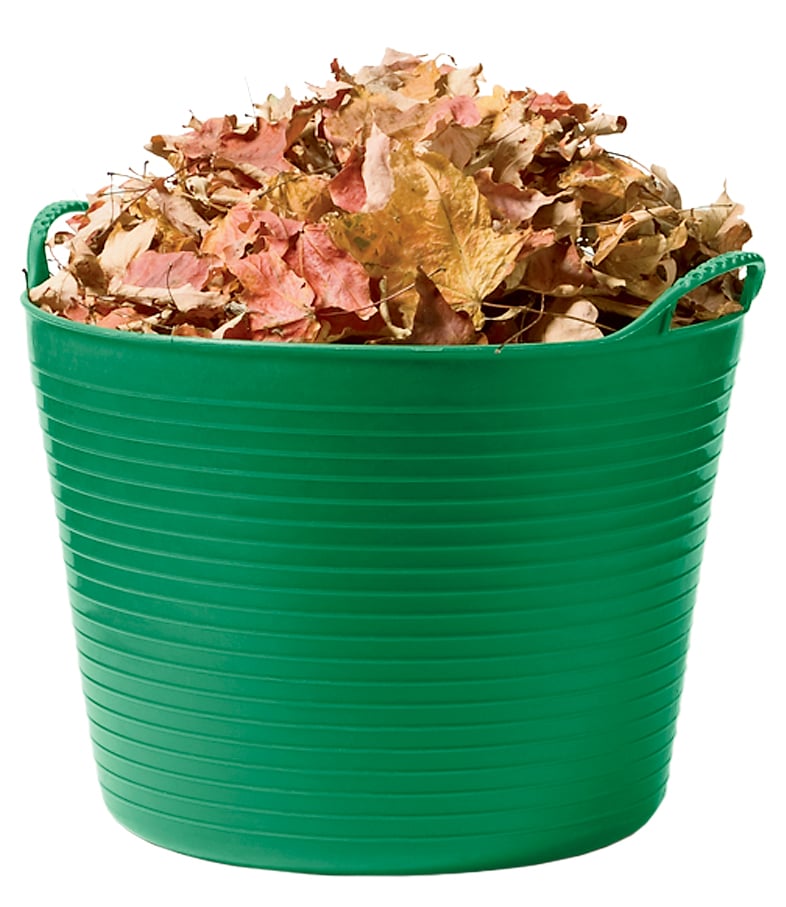What Happens If Too Much Compost Is Put Into Garden Soil In The Spring
More Articles
Find more garden information
Other Article Categories
Fall Soil Improvements
What to add? Compost, raw organic matter, and organic nutrients.

Autumn is a good time to improve your soil by adding raw organic matter, such as shredded leaves.
When the garden season winds down, the average gardener is heading for the hammock. But experienced organic gardeners know that fall is no time to be lazing about. It's the most important season of the year for improving your soil. What should you be adding to your soil this fall? Three things: finished compost, raw organic matter, and organic nutrients.
Compost
Whether you are using your own homemade compost, or are purchasing compost in bags or by the truckload, stock up early with as much as you can afford. I use up a couple yards of compost each fall (besides what I make in my own bins). It gets stockpiled on a big waterproof tarp, which allows me to keep things neat and keep the compost covered so it doesn't get soggy. My latest composting helper is an orange 11-gallon Tubtrug. I keep it full of compost and the bright color makes it easy to spot just about anywhere in the yard.
As you remove spent crops from the vegetable garden, use a garden fork to loosen the soil, and mix in a 3" to 4" layer of compost. While soil temperatures are still warm, the nutrients and organic matter in the compost will stimulate microbes and other beneficial organisms. Tired, end-of-season soil will be refreshed and renewed when spring comes around.
Flower gardens also need compost. As you begin cutting back and cleaning up your perennial beds, keep a good supply of compost at hand. Dig in some compost wherever you've pulled out annuals and whenever you're planting bulbs. Pile on a good 2" to 3" layer around the base of established perennials and shrubs (keeping it back an inch or so from the stems).
Planting new shrubs, trees or other landscape plants? Opinions vary, but I always mix a few shovels of compost with the soil that goes back into the planting hole.
Raw Organic Matter
The soil in your vegetable garden will probably be laying fallow over the winter months (unless you're lucky enough to garden year-round). To boost the amount of organic matter in your soil— beyond what you can get from finished compost— consider incorporating raw organic matter directly into the soil.
There's just one thing to keep in mind when you're adding raw organic matter to your soil. The beneficial soil organisms that will help decompose this material, require nitrogen to do their work. This means that if you don't add some additional nitrogen along with the organic matter, the microbes will start using up the nitrogen in your soil. To avoid this, you can either add some nitrogen-rich manure along with the raw organic matter, or sprinkle on some granular organic fertilizer.
Shredded leaves are my top choice for raw organic matter. Use a leaf shredder if you have one. If not, just mow over the leaves several times with your lawnmower.
Animal manures (but not from dogs or cats) are great for the soil. You can gather it in buckets, plastic trash bags, feed bags, or in the back of a pickup truck. A good thing about adding animal manures in the fall, is that it doesn't really matter if the manure is fresh or aged. Over the winter months, the caustic ammonia will dissipate, leaving behind valuable nutrients and organic matter.
Organic Soil Amendments
Most organic fertilizers release their nutrients slowly over many months, so applying them in the fall helps ensure they'll be available to your plants next spring. If you can get your hands on some kelp meal, greensand, rock phosphate, or bone meal, do so. Because it's the end of the season, your local garden center may even have some broken bags they'll be willing to sell you at a discount. You can mix these organic materials right into your garden (or side dress around plants), along with the shredded leaves, manure and compost. Breaking down organic material requires some nitrogen. To facilitate the process you can add All-Purpose Fertilizer or Super Hot.
If you suspect that your soil pH may need adjusting, autumn is the time to correct it. It's best to raise or lower soil pH slowly, over a three- to six-month period. Add lime in the fall to raise the pH level of your soil. Add acidifiers like pine needles, peat moss and elemental sulfur if your soil is too alkaline. Remember that unless you already know that your soil is too acidic or too alkaline, you should always do a soil test to determine the pH level before taking corrective measures.
Better Soil — Better Garden
Improving the soil in your garden makes a huge difference in its ability to retain water, support healthy plant growth, and help your plants fend off diseases, pests and other stresses. Whether you're new to gardening, or a seasoned pro, building better soil is the single most important thing you can do to improve your gardening success. And fall is the best time to do it! To learn more, read Building Healthy Soil.
Last updated: 09/22/2021
People who read this article often purchase
Get the Dirt
Stay up to date on new articles and advice. Please fill out the information below.
What Happens If Too Much Compost Is Put Into Garden Soil In The Spring
Source: https://www.gardeners.com/how-to/fall-soil-improvements/7036.html
Posted by: salazarexions.blogspot.com

0 Response to "What Happens If Too Much Compost Is Put Into Garden Soil In The Spring"
Post a Comment